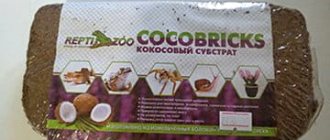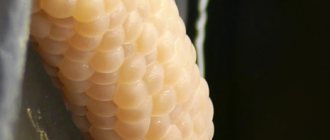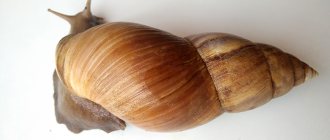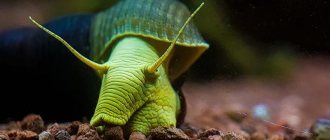Anyone who keeps snails should understand that the health of their pets depends on the conditions under which they are kept. Thus, snails require a terrarium. It is most important. In second place is land for snails. Which is used for filling. Thanks to high-quality filler, you can create conditions as close as possible to natural ones.
Thanks to the soil, the required level of humidity is maintained in the terrarium.
The most popular option is coconut substrate. It is not difficult to understand how to use this type of filler. The main thing is to prepare and process it correctly. You can find several coconut-based fillers on the market. Which one to choose depends on the preferences of the snail owner.
Why does a snail need soil?
Thanks to the soil, the required level of humidity is maintained in the terrarium. It is recommended to spray it several times throughout the day. To do this, use a spray bottle.
The substrate layer is made from 10 to 15 cm. Snails will be able to burrow into a substrate of this thickness without hindrance. Here they rest, hiding from direct sunlight. The product chosen is quite loose. So that mollusks can burrow into it without hindrance.
At the bottom of the terrarium, snails lay eggs. They also prepare a place where the offspring will grow.
The substrate layer is made from 10 to 15 cm
If a snail falls from the wall of the terrarium, the soil will absorb the fall. As a result, the shell will remain intact, and the mollusk will not die.
How often to change the soil in a terrarium
Change the soil in the snail's terrarium once every two to three weeks. If you hear an unpleasant odor or midges appear in the terrarium, change the substrate immediately. Read our article .
The substrate does not have to be completely changed; it can be washed and scalded with boiling water several times, then add a little fresh soil and loosen it. This rule does not apply to the container for laying eggs, since after washing the soil, the humidity in the terrarium changes, and as a result, the clutch dies. No matter how much you restore order and cleanliness, Achatina will still burrow and bury small uneaten pieces of food. Read how to properly set up a terrarium for a snail here.
To make it convenient to remove soil from the terrarium for washing and complete replacement. Take a thick plastic bag, the size of its bottom should be the same as the bottom of the terrarium. Cut off the bottom edge of the bag, then pour soil into the resulting pocket and lower it to the bottom of the terrarium. Mask the protruding edges of the bag with moss or live plants.
What is coconut substrate
Coconut substrate is the recycled inner husk and shell of coconuts. This product is popular among flower growers. If you dilute it, you can grow flowers and seedlings. In addition, it is used as a filler for terrariums. This product has been used to keep snails since the beginning of 2007.
Benefits of Coconut Soil
This type of soil has many advantages:
- In the production process, environmentally friendly and natural ingredients are used.
- Excellent moisture retention. If the material begins to dry out, it becomes light.
- Does not cake, snails will not suffocate. They love to burrow.
- All existing pathogenic microorganisms die.
- A neutral product, which is very important when caring for snails.
- If washed and treated thoroughly, it can be used several more times.
This type of soil has many advantages
Some snail breeders note that after transferring to coconut shavings, the mollusks rise to the walls of the terrarium. It's quite normal. The substrate contains some salt content. Therefore, the purchased product must be thoroughly washed under running water.
How to prepare coconut substrate
It is important to know how to prepare coconut substrate for snails. The first step is to soak the briquette. To do this, it is placed in a deep basin or bucket. The choice of container depends on how many liters of substrate are required. Everything is poured with boiling water. The soil must be completely covered with water. Leave to cool at room temperature. It is worth considering that when in contact with water, coconut increases in volume. If the briquette is 2 liters, then add about 1-1.5 liters of water.
The first step is to soak the briquette
The packaging indicates how much you will end up with. If the briquette is large enough, then use some of it. The product is quite tough. It's difficult to cut. It is recommended to prepare notches along the die. Then the desired part is separated with a hatchet.
The product is quite hard
When the substrate has cooled, it is transferred to a sieve or gauze. Rinse under running water. Until the water is clean. If there is an unpleasant odor, rinse again.
Feeding the Achatina snail
It is better to feed as food is eaten and dried and remove any leftovers. Achatina eats vegetables, fruits and herbs, but in nature they do not refuse meat. Usually in captivity they are fed cabbage, carrots and cucumbers, but it is preferable to give them a more varied diet. This is necessary first of all so that at any moment you can switch to another available type of food. It is known that snails have certain food preferences, including many who prefer cucumbers and lettuce to other foods and, if they are fed only cucumbers from childhood, they often refuse to eat anything other than them, which can cause some inconvenience. Large snails can be given whole cores; they process food waste surprisingly quickly. Soft foods should be given only for a short period of time, otherwise they will flow and spread across the soil, causing it to become contaminated. It is generally not recommended to give soft foods to small snails. There was a case when snails buried themselves entirely in a banana and suffocated there. It is better to give very small newborn snails greens, grated carrots, and after a few days lettuce and an apple.
Can:
Fruits: apple, apricots, pineapple, avocado, bananas, pear, wild strawberry, strawberry, cherry, mango, papaya, plums, bunch of grapes, figs, watermelon, melon.
Vegetables: pumpkin, rutabaga, zucchini, broccoli, champignons, lettuce, cucumber, potatoes (boiled), carotel carrots, red peppers, celery, spinach, tomato, cabbage leaves.
Beans, peas (cooked or fresh), oatmeal.
Other: mushrooms, meadow plants/trees, nettles, daisy flowers, elder flowers, clover, dandelion, plantain, yarrow, sprouted oats, alfalfa, fruit tree blossoms (apple, apricot, peach...), bread (softened), milk (powdered) or natural), dairy/lactic acid products (without sugar, salt, spices), minced meat (minced meat, raw or boiled meat), egg (boiled), compound feed, meat and bone meal, peanuts (chopped), vegetable and meat baby food, gammarus.
It is important that the plants are not picked within the city, factories or enterprises, wastewater, or landfills. After you bring it home, rinse thoroughly in warm water!
You can’t (very important!):
Spicy, salty, sour, sweet, smoked, fried, pasta, potato eyes.
Overview of soil types
Coconut substrate comes on sale in the form of briquettes, which are very well compressed. The finished product differs in the fraction of incoming particles.
Coconut substrate comes on sale in the form of briquettes, which are very well compressed
Conventionally, soil is divided into several categories:
- intended for growing indoor flowers and seedlings;
- intended for terrariums.
Essentially, it's the same thing. However, it is recommended to purchase specifically for terrariums. At the same time, they choose pet stores for purchases, not flower shops. This is due to the fact that the special product is much cleaner. Great for pets.
Coconut substrate is the recycled inner husk and shell of coconuts.
Flower soil may contain some impurities. Including chemical ones. Insect larvae can often be found. It's difficult to see them at first glance. But after a while they will begin to grow and multiply. It is worth carefully inspecting the packaging. It says what or who the product is for.
Chips
Chips are fairly large pieces of coconut shells. The moisture capacity is quite low. This option is used for growing flowers. Namely, for orchids or for reptiles. It is not recommended for land snails to place such material in their terrarium. It is very difficult to bury yourself in it. Since the shell pieces are large, the snails will feel uncomfortable.
Fiber
Another option is coconut fiber. This material consists of fairly thin and strong threads of great length. Feature – retains moisture well. However, many snail experts claim that such soil is only suitable for adult snails. Young animals, due to inexperience, burrow into the fibers. Since it is difficult to get out of them, the mollusks suffocate. If possible, it is better to choose another product.
Coconut substrate
Coconut substrate is sold in specialized stores in briquettes. The fraction can be small or large. Coconut fiber is considered a universal substrate. Great for keeping pets. Retains moisture perfectly and does not stain the terrarium. It is neutral, which is very important for snails. During their life, burns do not appear on the body of gastropods. Parasites and harmful microorganisms are completely absent.
Neutralized peat
Peat is perfect for an area or for the entire aquarium. This material has a fairly fine fraction. In appearance it resembles a fine powder. Excellent for growing gastropods of any size. Retains moisture well. Has no harmful effects.
It goes on sale in the form of pressed briquettes. They must be pre-soaked. Only after this can you send it to the terrarium. The weight of the briquette ranges from 05 to 5 kg.
Peat is perfect for an area or for the entire aquarium.
Can be purchased in tablet form. They are produced in a special mesh shell. It is recommended to purchase the product in specialized stores, pharmacies or pet stores. It is not recommended to use filler intended for growing flowers.
Land collected in the suburbs
The soil is not suitable for keeping snails. However, if it was collected in the forest, then you can use it. It should not contain fertilizers, pesticides, or feces. Fresh soil is immediately poured into the terrarium. Pre-treatment required. To do this, place the soil in a heated oven for 15 minutes. They bake well. After complete cooling, add a small amount of edible chalk.
Pros and cons of suitable soils
The advantage of such soil as earth is its softness and friability. The disadvantage is that the raw materials intended for plants are not suitable due to the fertilizers they contain. They are capable of killing a snail.
The advantages of leaf litter are that the mollusk cannot be injured by it and does not stain the ulitaria. However, it is not suitable as an independent bedding. In addition, it does not hold moisture well.
Coconut substrate has no disadvantages. But it has a lot of advantages. Firstly, it is a good moisture absorber, and secondly, it does not pollute the mollusk and its house. Thirdly, it has a neutral acid-base environment. Fourthly, there are no bacteria or parasites in the substrate. In addition to the above, it is the most popular and versatile underlay available.
The advantages of peat are good moisture absorption and retention. In addition, it is easy to find on sale. The downside is low acidity, which can cause a burn to the mollusk body.
Forest moss or sphagnum has excellent hygroscopicity, is a “living” hygrometer and does not stain the snail and the walls of the terrarium. In addition, bacteria are not able to multiply in it. There are no disadvantages.
Walnut shells have poor absorbency. This is the only drawback. Pros: the substrate does not stain the house, the animal does not reproduce too actively in the shell, and in addition, it cannot be injured.
To summarize, we can say that each type of soil has its own characteristics. However, coconut and moss for Achatina snails are considered the best options.
Coconut substrate can be prepared at home. There are two ways.
- The raw material is soaked in a container with hot water, and after swelling, it is washed through a sieve until clean streams begin to flow from it. Then the substrate is again doused with boiling water, washed in warm water and wrung out.
The next stage is calcination in an oven heated to 200 degrees or more.
- The material is also soaked in hot water, and after soaking it is placed in a pan and boiled for about 50-60 minutes. Next, it is washed through a sieve, wrung out, dried and placed in the terrarium.
Prohibited soils
Prohibited types of soil include:
- sawdust - can scratch the throat and body, and stuck drifts are causes of inflammation. In addition, a white coating forms on the shell, which is quite difficult to clean. Another drawback is poor absorption, which causes water to stagnate at the bottom and go stale;
- sand - also scratches the shell and insides and is practically not removed from the body. In addition, it retains moisture poorly;
- small pebbles and river pebbles - do not absorb moisture at all, scratch the mollusk and can cause serious damage and even death;
- clay – tends to turn into mud when saturated with water. In addition, it is too dense, and when dry it is not as loose as soil.
Soil replacement
The soil used for terrariums needs to be changed periodically. Replacement or treatment is carried out as necessary - when the substrate becomes contaminated. The procedure is carried out at least once every 3 weeks. Sometimes midges, nematodes, and an unpleasant odor appear. In this case, the replacement is made without delay. Hygienic treatment is carried out daily.
The soil used for terrariums needs to be changed periodically
The soil can be changed and processed only in those terrariums where adult snails are kept. If there are layings of caviar, then work should be temporarily stopped. If the temperature changes, all offspring will die.
How often to change coconut soil
Land snails are unpretentious. However, despite this, they must be kept clean. It is recommended to remove any remaining food and feces from the bottom every day. Because they will begin to decompose. Once a week, a small amount of new substrate is added to the terrarium. Which is pre-processed.
Once a week, add a small amount of new substrate to the terrarium.
Snail breeders claim that many types of mollusks react poorly to the new substrate. Especially if you change it all at once. It is for this reason that once every few weeks it is worth taking out the old substrate and pouring boiling water over it. Then put it back. Add new soil. This should be done carefully. In small portions.
How to replace soil for seedlings?
Sawdust This is the most economical material that is suitable for sowing all crops. To grow seedlings, fine sawdust, preferably from deciduous trees, is poured with boiling water several times. This will help get rid of not only resin, but also pathogenic bacteria.
Interesting materials:
How to promote an article in Yandex Zen? How to ride the Metro Exodus trolley? How to pass intersections with a tram? How to run ink through a printer? How to warm up onion sets? How to show your feelings to a guy? How will May 9, 2021 take place? How does embalming take place in a morgue? How does delivery by Europost courier work? How does the cycle of substances occur in nature?
Advantages and disadvantages
Coconut flakes have advantages and disadvantages. These points must be studied.
The advantages include:
- Environmentally friendly product.
- Completely safe for snails.
- It absorbs moisture perfectly and maintains a favorable microclimate in the terrarium.
- Quite loose and soft. Over time, lumps do not appear.
- After drying, the properties remain the same.
- Neutral substrate.
- Excellent as the main soil for keeping land mollusks.
- Easy to handle.
- After processing it can be reused.
- Affordable price.
Despite this, coconut peat briquettes have disadvantages:
- Snails, looking for food and nutrients, can absorb the substrate. If coconut filler is consumed in large quantities, the mollusk will die. However, this is characteristic only of wild individuals. Domestic snails get everything they need from food. Therefore, soil is not perceived as food.
- If the processing is performed poorly, potassium and sodium salts remain. Therefore, the processing process should be approached qualitatively.
Snail breeders claim that many types of mollusks react poorly to the new substrate
If the question arises about what kind of soil is needed for snails, then you should safely take coconut filler.
Cleaning
Cleaning the terrarium should be carried out at least once a week. As for replacing water and cleaning up uneaten food, this task must be addressed daily. If ticks and other parasites are found, the substrate should be removed immediately.
Regardless of the filler of the substrate, for complete cleaning, it is necessary to remove the inhabitants of the snail house. If the water quality allows, they can be washed with warm water in the shower. When, after the first use of water procedures, there is no plaque left on the sink, then you can safely carry out them in the future.
Get a separate sponge for cleaning the container and use only that. There is no need to use chemical detergents to wash the walls, bottom and lid. All you need is a sponge and warm water.
After bathing, it is advisable to wipe the surface of the sink with sesame oil . This will prevent drying out.
What should be in a snail container?
How to equip a container with snails with soil, driftwood, branches and moss. ... Choosing a container for keeping Achatina
- the shape should not be round;
- the walls should be transparent or matte;
- do not use plywood or cardboard box;
- a lid is required;
- made from safe materials.
Interesting materials:
How can you glue the canvas? How can you rinse your nose? How can you dissolve fat? How can I dilute the marker? How can you disassemble an iPhone 5? How can you cut glass at home? How can you break a stone wall in Rust? How can you collect sea buckthorn? How can you remove ink from a white bag? What can replace orange sticks for manicure?











